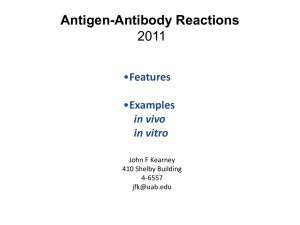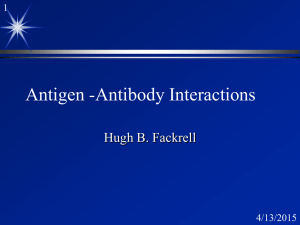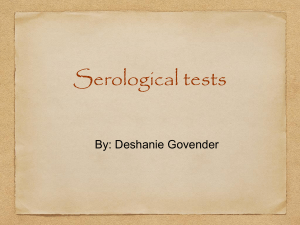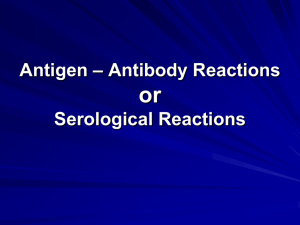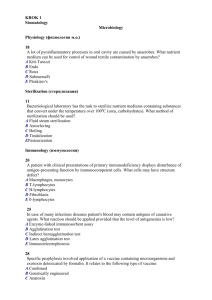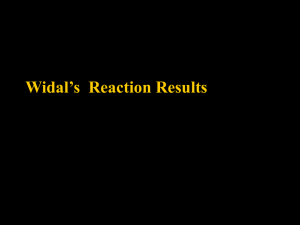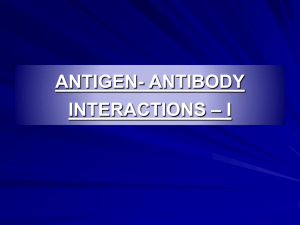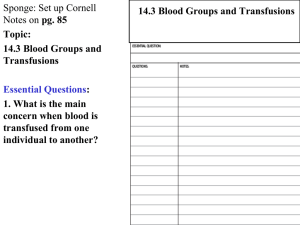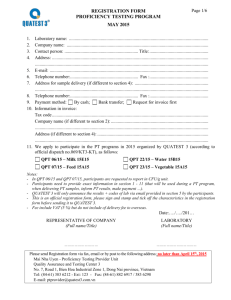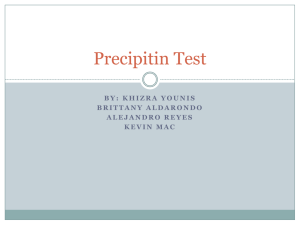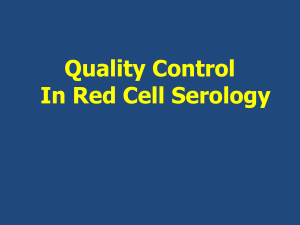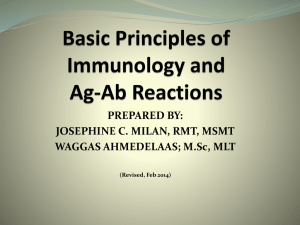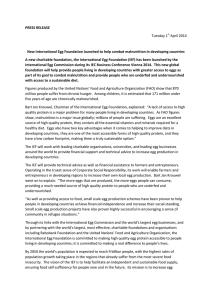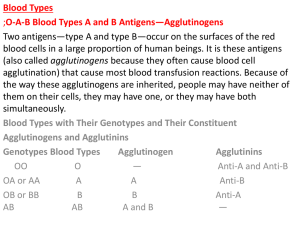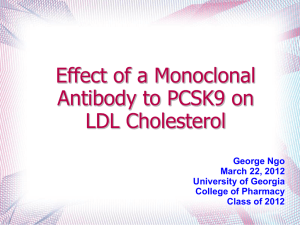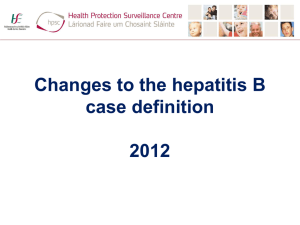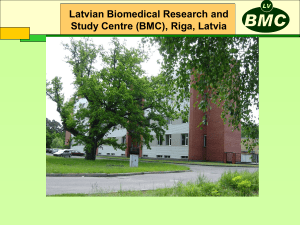Gram Reaction
advertisement
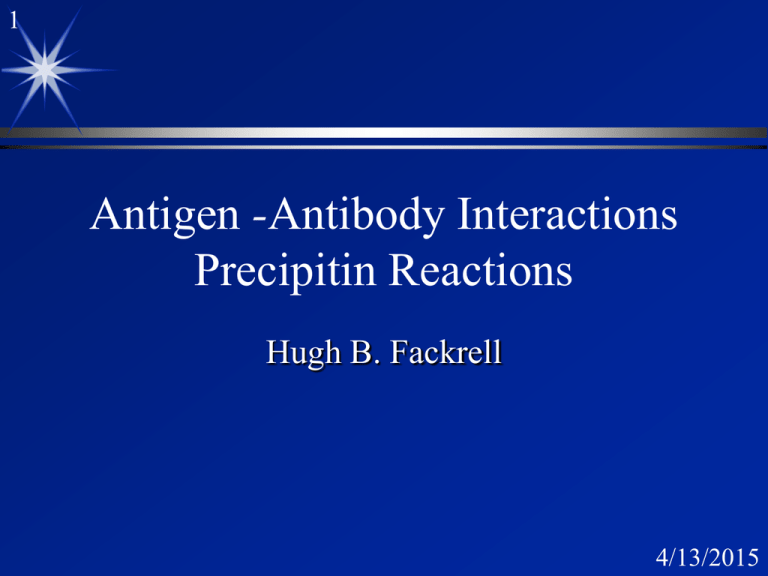
1 Antigen -Antibody Interactions Precipitin Reactions Hugh B. Fackrell 4/13/2015 2 Antigen-Antibody Interactions Assigned Reading Content Outline Performance Ojectives Key terms Key Concepts Short Answer Questions 4/13/2015 3 Assigned Reading Chapter: 6 pp 144-164 Janis Kuby’s Immunology 3rd Ed 4/13/2015 4 Content Outline Strength of Antigen-Antibody Interactions Cross Reactivity Precipitin Reactions Agglutination Reactions 4/13/2015 5 Strength of Antigen-Antibody Interactions affinity avidity 4/13/2015 6 Cross reactivity 4/13/2015 7 Mammoth 4/13/2015 8 Precipitin Reactions reactions in fluids reaction in gels radial immunodiffusion Ouchterlony immunoelectrophoresis 4/13/2015 9 Ring Test 4/13/2015 10 Ring Test: Controls 4/13/2015 11 C reactive Protein ring test 4/13/2015 12 QPT 4/13/2015 13 QPT: Zones 4/13/2015 14 QPT:# Epitopes 4/13/2015 15 4/13/2015 16 QPT: Simple system 4/13/2015 17 QPT: Multiple Interactions 4/13/2015 18 QPT: Multiple Reactions 4/13/2015 19 Radial Immuno Diffusion 4/13/2015 20 Double Immuno Diffusion 4/13/2015 21 Immunodiffusion: Single reactions 4/13/2015 22 4/13/2015 23 4/13/2015 24 Immunoelectrophoresis 4/13/2015 25 Counter Immuno Electrophoresis Fig 12-7 Barrett 1988 4/13/2015 26 IEF: Concept 4/13/2015 27 IEF: IgG IgM IgA 4/13/2015 28 IEF: Partial Identity 4/13/2015 29 IEF: Human Serum 4/13/2015 30 Rocket Immunoelectrophoresis 4/13/2015 31 Rocket Immunoelectrophoresis 2 4/13/2015 32 Rocket Immunoelectrophoresis 3 4/13/2015 33 Agglutination Reactions hemagglutination bacterial agglutination passive agglutination agglutination inhibition 4/13/2015 34 4/13/2015 35 Hemagglutination 4/13/2015 36 The End 4/13/2015 37 Performance Objectives Key terms, concepts short answers 4/13/2015 38 Key Terms agglutination, direct agglutination reaction, indirect agglutination reaction antibody affinity, antiserum, association constant (K), average affinity, average intrinsic association constant(Ka), avidity, ELISA, equilibrium constant, equilibrium dialysis, fluorescein, fluorochromes, hemagglutination, 4/13/2015 39 passive hemagglutination, passive hemagglutination inhibition, reverse passive hemagglutination, immune precipitation, immunoelectrophoresis immunofluorescence, Indirect fluorecent antibody test, ring test, 4/13/2015 40 Ouchterlony methods, plasma, primary antigen-antibody interactions, Radioimmunoassay(RIA Rhodamine, secondary antigen-antibody interactions, serology, serum, titer, zone phenomena (antibody excess, antigen excess, equivalence) 4/13/2015 41 Key Concepts Explain a primary antigen-antibody interaction and include at least three important characteristics. Describe the forces that encourage primary antigen-Antibody interactions Assess the reasons for using the different gel preciptitin reactions 4/13/2015 42 Distinguish betweeen antibody affinity and avidity. Describe the strength of the primary antigen-antibody interactions using equilibrium dialysis. Include the terms K and Ka Compare and contrast RIA and ELISA Describe direct and indirect fluorescent antibody methods. Explain zone phenomena. 4/13/2015 43 Describe a secondary antigen-antibody interaction in terms of lattice formation and antigen:antibody ratios. Construct a table to compare the various procedures used to determine the presence of soluble antigen or antibody in a fluid and in a gel. Distinguish between agglutination and preciptin reactions and give the advantages and disadvantages of each. 4/13/2015 44 Short Answer Questions 4/13/2015 45 Cross reactivity of antibodies creates problems for their application in serology. Explain. Differentiate between a primary and a secondary antigen-antibody reaction. What are three important characteristics that distinguish the two reactions? 4/13/2015 46 What kinds of noncovalent interactions are important in antigen-antibody interactions? What aspect of these interactions is most important and why? How is equilibrium dialysis used to measure PRIMARY antigen-antibody reactions? Differentiate between avidity and affinity. 4/13/2015 47 Discuss the term lattice formation. What are the pros and cons of RIA? Describe two types of immunofluorescence tests. What is the advantages of the indirect procedure over the direct procedure? What are some commonly used fluors? What colour does each fluor emit? What makes precipitin reactions visible? 4/13/2015 48 What two factors are important in the development of precipitin reactions? Three patterns can be observed in the Ouchterlony test. DRAW and LABEL diagrams to illustrate these patterns. What does each pattern show? What is the major advantage of immunoelectrophoresis over immunodiffusion? What are the disadvantages? 4/13/2015 49 How does agglutination differ from precipitation? Why are agglutinatin tests more sensitive that precipitin tests? Differentiate between direct and indirect agglutination reactions? What is a major advantage of indirect agglutination reaction over direct reactions? 4/13/2015 50 Ouchterlony 4/13/2015 51 Ouchterlony:Partial Identity 4/13/2015
